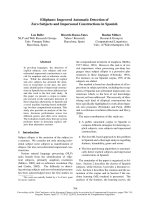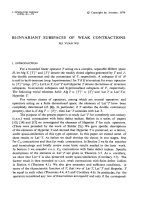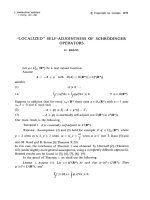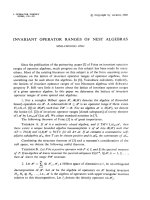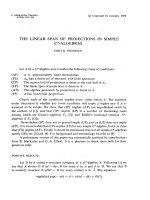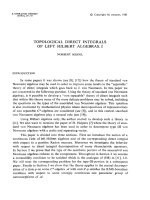Báo cáo toán học: "All regular multigraphs of even order and high degree are 1-factorable" docx
Bạn đang xem bản rút gọn của tài liệu. Xem và tải ngay bản đầy đủ của tài liệu tại đây (101.37 KB, 8 trang )
All regular multigraphs of even order and high degree
are 1-factorable
Michael J. Plantholt
Shailesh K. Tipnis
Department of Mathematics
Illinois State University
Normal, IL 61790-4520, USA
,
Submitted: March 13, 2001; Accepted: December 8, 2001.
Mathematical Reviews Subject Classification (2000): 05C15, 05C70
.
Abstract
Plantholt and Tipnis (1991) proved that for any even integer r,aregularmulti-
graph G with even order n, multiplicity µ(G) ≤ r anddegreehighrelativeton and
r is 1-factorable. Here we extend this result to include the case when r is any odd
integer. H¨aggkvist and Perkovi´c and Reed (1997) proved that the One-factorization
Conjecture for simple graphs is asymptotically true. Our techniques yield an ex-
tension of this asymptotic result on simple graphs to a corresponding asymptotic
result on multigraphs.
1 Introduction
Let G be a multigraph with vertex set V (G)andedgesetE(G). We denote the maximum
degree of G by ∆(G), the minimum degree of G by δ(G) and the multiplicity of G,that
is, the maximum number of parallel edges between any pair of vertices of G by µ(G). G
is said to be simple if µ(G)=1. WesaythatG is 1-factorable if the edges of G can
be partitioned into 1-factors of G. Wedenotebysimp(G), the simple graph underlying
G, i.e. simp(G) is the graph obtained by replacing all edges of G with multiplicity
greater than one by single edges. In this paper, a decomposition of G into edge-disjoint
subgraphs H
1
,H
2
, ,H
k
of G means a partition of E(G) into the union of the edge sets
of H
1
,H
2
, ,H
k
, and we abuse the notation and write G = H
1
∪ H
2
∪ ∪ H
k
instead
of E(G)=E(H
1
) ∪ E(H
2
) ∪ ∪ E(H
k
). The reader is referred to Bondy and Murty [2]
for all terminology undefined in this paper. The following long-standing conjecture whose
the electronic journal of combinatorics 8 (2001), #R41 1
origin is unclear claims that any regular, simple graph of even order and with degree at
least half the number of vertices is 1-factorizable (see [10]).
One-factorization Conjecture Let G be a ∆-regular simple graph with even order n.
If ∆ ≥
1
2
n then G is 1-factorable.
This conjecture is best possible as indicated by the example when G consists of two
disjoint copies of K
3
. An example of a connected graph to illustrate that Conjecture 1 is
best possible is obtained by taking two disjoint copies of K
5
− e where e is any edge of
K
5
and joining the corresponding end-vertices of e in the two copies of K
5
− e by edges.
Chetwynd and Hilton [3] proved that Conjecture 1 is true if we replace the condition that
∆(G) ≥
1
2
n in Conjecture 1 by the stronger condition that ∆(G) ≥
√
7−1
2
n.
Theorem 1 (Chetwynd and Hilton [3]) Let G be a simple graph with even order n.IfG
is ∆-regular with ∆ ≥
√
7−1
2
n then G is 1-factorable.
H¨agkvist [6] and Perkovi´c and Reed [7] proved that Conjecture 1 is asymptotically
true.
Theorem 2 (H¨aggkvist [6], Perkovi´c and Reed [7]) For every >0, there exists N()
such that if G is a simple graph that is ∆-regular with even order n>N() and with
∆ ≥ (
1
2
+ )n, then G is 1-factorable.
We offer the following natural extension of the One-factorization conjecture to multi-
graphs.
Multigraph One-factorization Conjecture Let G be a ∆-reg ular multigraph with
even order n and multiplicity µ(G) ≤ r.If∆ ≥
1
2
rn then G is 1-factorable.
In this paper we prove extensions of Theorems 1 and 2 to multigraphs as given in
Theorems3and4below.
Theorem 3 Let G be a ∆-regular multigraph with even order n and multiplicity µ(G) ≤ r.
(i) If r is even and ∆ ≥
√
7−1
2
n +1r, then G is 1-factorable.
(ii) If r is odd and ∆ ≥
√
7−1
2
n +2r +1, then G is 1-factorable.
Theorem 4 For every >0, there exists N
∗
() such that if G is a ∆-regular multigraph
with µ(G) ≤ r and even order n>N
∗
(), then G is 1-factorizable if
(i) r is even and ∆ ≥ (
1
2
+ )rn,or
(ii) r is odd and ∆ ≥ (
1
2
+
1
2r
+ )rn.
the electronic journal of combinatorics 8 (2001), #R41 2
The proof of part (i) of Theorem 3 appeared in [8]. The approach taken in this proof
was to decompose the edges of the multigraph G with even order n and multiplicity
µ(G) ≤ r (where r is even) into a relatively small number of 1-factors of G and a number
of regular, simple graphs, each with degree high relative to n. Theorem 1 was then applied
to each of the simple graphs in the decomposition to yield a 1-factorization of the original
multigraph G. In Section 2 of this paper we use this decomposition result for the case
when r is even and Tutte’s f-factor theorem [9] to obtain a similar decomposition of the
edges of G with even order n and multiplicity µ(G) ≤ r,wherer is odd. In Section 3 we
use our decomposition result from Section 2 to prove Theorem 3 and Theorem 4.
2 Decomposition of regular multigraphs into regular
simple graphs
The following decomposition result for regular multigraphs G with even order n,multi-
plicity µ(G) ≤ r,wherer is even, and with degree high relative to n and r was proved
in [8]. Many similar results on decompositions of multigraphs into simple graphs were
obtained in [5].
Theorem 5 (Plantholt and Tipnis [8]) Let G be a ∆-regular multigraph with even order
n and multiplicity µ(G) ≤ r, where r is an even integer. If ∆=kr + r for some integer
k ≥
n
2
, then the edges of G can be decomposed into r 1-factors of G and rk-regular simple
graphs.
We will prove the following theorem that extends Theorem 5 to the case when r>1is
an odd integer.
Theorem 6 Let G be a ∆-regular multigraph with even order n and multiplicity µ(G) ≤ r,
where r>1 is an odd integer. If ∆=kr +2r +1 for some integer k ≥
n
2
+
n
2r
, then the
edges of G can be decomp osed into 2r 1-factors of G,a(k +1)-regular simple graph, and
(r − 1) k-regular simple graphs.
In order to prove Theorem 6 we will need Theorem 7 and Theorem 8 stated below.
Theorem 7 is a classic result of Dirac [4] giving a sufficient condition for the existence of
a Hamilton cycle in a simple graph and Theorem 8 is a classic result of Tutte [9] giving
a necessary and sufficient condition for the existence of an f-factor in a multigraph G.
Theorem 7 (Dirac [4]) Let G be a simple graph with order n ≥ 3.Ifδ(G) ≥
1
2
n then G
contains a Hamilton cycle.
We now define some terminology needed to state Tutte’s f-factor theorem. See Bollob´as
[1] for most of this terminology and the statement of Theorem 8. We will denote the
degree of vertex v ∈ V (G)bydeg
G
(v). Let G be a multigraph and suppose that each
v ∈ V (G) is assigned a positive integer f (v). An f -factor of G is a spanning subgraph
F of G such that deg
F
(v)=f (v) for each v ∈ V (G). For X, Y ⊆ V (G)wedenote
the electronic journal of combinatorics 8 (2001), #R41 3
by (X, Y ; G) the set of edges of G that have one end-vertex in X and the other end-
vertex in Y . For disjoint subsets D, S ⊆ V (G) and a component C of G − D − S,we
define ρ(D, S; C)=|(C, S; G)| +
x∈C
f(x). Component C is said to be an odd or even
component of G − D − S with respect to D and S according as ρ(D, S; C) is odd or even.
The number of all odd components of G − D − S is denoted by q[D, S; G].
Theorem 8 (Tutte [9]) Let G be a m ultigraph and suppose that each v ∈ V (G) is assigned
a positive integer f(v). Then, G has an f-factor if and only if
q[D, S; G]+
x∈S
f(x) ≤
x∈S
deg
G−D
(x)+
x∈D
f(x)
for all disjoint subsets D, S ⊆ V (G).
We mention here that in proving Theorem 5, we will only use the sufficiency of a condition
stronger than the condition in Theorem 8 to guarantee an f-factor in a certain multigraph.
We need two Lemmas before we turn to the proof of Theorem 6.
Lemma 1 Let G be a ∆-regular multigraph with maximum multiplicity µ(G) ≤ r and
suppose that ∆=rs. Suppose that G contains
r
2
edge-disjoint Hamilton cycles such
that for all u, v ∈ V (G),if t of these Hamilton cycles contain an edge of the form (u, v),
then the multiplicity of the edge uv in G is at most r − t. Then, G contains a simple
s-factor F such that µ(G − F ) ≤ r − 1.
Proof. Let G
be the graph obtained from G by deleting all sets of r parallel edges. Note
that since deg
G
(v) is a multiple of r for each v ∈ V (G), deg
G
(v) is also a multiple of r for
each v ∈ V (G
). Moreover, since G
contains all edges from the
r
2
Hamilton cycles in G,
deg
G
(v) > 0 for each v ∈ V (G
). Define f (v)=
1
r
deg
G
(v) for each v ∈ V (G
). Then, it
is clear that G contains a simple s-factor F such that µ(G − F) ≤ r − 1 if and only if G
has a simple f -factor.
From Theorem 8, to show that G
has a simple f -factor it suffices to show that
q[D, S;simp(G
)] +
x∈S
f(x) ≤
x∈S
deg
simp(G
−D)
(x)+
x∈D
f(x)(1)
for all disjoint subsets D, S ⊆ V (simp(G
)).
Let D, S ⊆ V (simp(G
)) be disjoint subsets. It is easy to check that each term in
inequality (1) is zero if D = ∅ and S = ∅. So, for the rest of the proof, assume that
D ∪ S = ∅.LetC denote the multigraph simp(G
) − D − S and suppose that the
multigraph C consists of k components. We examine in turn, the three summations in
inequality (1). First, by the definition of f,wehavethat
x∈S
f(x)=
1
r
x∈S
deg
G
(x)=
1
r
x∈S
deg
(G
−D)
(x)+
1
r
|(S, D; G
)|. (2)
To examine the second sum in inequality (1), let G
+
be the multigraph whose underlying
simple graph is simp(G
) and the multiplicity of each of whose edges is r.Letl denote
the electronic journal of combinatorics 8 (2001), #R41 4
the number of edges (including multiplicity) from the
r
2
edge-disjoint Hamilton cycles
of G (as in the statement of Lemma 1) that are also in (C, S; G). The definition of G
+
implies that
x∈S
deg
simp(G
−D)
(x)=
x∈S
deg
simp(G
+
−D)
(x)=
1
r
x∈S
deg
(G
+
−D)
(x).
Now, since for all u, v ∈ V (G), if t of the
r
2
edge-disjoint Hamilton cycles of G (as in
the statement of Lemma 1) contain an edge of the form (u, v), then the multiplicity of
the edge uv in G is at most r − t,wehavethat
x∈S
deg
simp(G
−D)
(x)=
1
r
x∈S
deg
(G
+
−D)
(x) ≥
l
r
+
1
r
x∈S
deg
(G
−D)
(x). (3)
Finally, for the third sum in inequality (1), the definition of f implies
x∈D
f(x)=
1
r
x∈D
deg
G
(x) ≥
1
r
|(D, S; G
)| +
1
r
|(D, C; G
)|.
Note that since G contains
r
2
Hamilton cycles and none of the edges in these Hamilton
cycles have multiplicity r,wehavethat|(C, D
S; G
)|≥
r
2
2k. Hence we have that,
x∈D
f(x) ≥
1
r
|(D, S; G
)| +
1
r
|(D, C; G
)|≥
1
r
|(D, S; G
)| +
1
r
(rk − l). (4)
Now, combining the fact that q[D, S; G
] ≤ k with equation (2) and inequalities (3) and
(4) easily yields the desired inequality (1).
Lemma 2 Let G be a ∆-regular multigraph with even order n and multiplicity µ(G) ≤ r,
where r>1 is an odd integer. If ∆=kr +2r +1for some integer k ≥
n
2
+
n
2r
, then G
contains
r
2
identical pairs of edge-disjoint Hamilton cycles.
Proof. For a multigraph H,denotebyH2 the spanning subgraph of H whose edge set
consists of all edges of H with multiplicity at least two. Suppose that H is a ∆-regular
multigraph with even order n and multiplicity µ(H) ≤ r,wherer>1 is an odd integer.
If ∆ ≥
nr
2
+
n
2
then deg
simp(H2)
(v) ≥
n
2
for each v ∈ V (H), because deg
simp(H2)
(v) <
n
2
for
some v ∈ V (H) implies that deg
H
(v) <
rn
2
+(n − 1) −
n
2
=
rn
2
+
n
2
− 1, a contradiction.
Now let G be a ∆-regular multigraph with even order n and multiplicity µ(G) ≤ r,
where r>1 is an odd integer, and ∆(G)=kr +2r + 1 for some integer k ≥
n
2
+
n
2r
.
Then, ∆(G) ≥
nr
2
+
n
2
+2r + 1 and so, deg
simp(G2)
(v) ≥
n
2
for each v ∈ V (simp(G2)).
Hence, Theorem 7 implies that simp(G2) contains a Hamilton cycle which in turn implies
that G contains a pair of identical Hamilton cycles. We remove this pair of identical
Hamilton cycles from G and claim that we can iterate this procedure
r
2
times. This
claim is justified because iterating the procedure i times leaves a regular multigraph G
i
the electronic journal of combinatorics 8 (2001), #R41
5
with even order n and multiplicity µ(G
i
) ≤ r,wherer>1 is an odd integer, and with
∆(G
i
) ≥
nr
2
+
n
2
+2r +1− 4i ≥
nr
2
+
n
2
if i ≤ (
r
2
−1).
We now use the results in Lemma 1 and Lemma 2 to prove Theorem 6.
Theorem 6 Let G be a ∆-regular multigraph with even order n and multiplicity µ(G) ≤ r,
where r>1 is an odd integer. If ∆=kr +2r +1 for some integer k ≥
n
2
+
n
2r
, then the
edges of G can be decomp osed into 2r 1-factors of G,a(k +1)-regular simple graph, and
(r − 1) k-regular simple graphs.
Proof. Let G be any ∆-regular multigraph with even order n and multiplicity µ(G) ≤ r,
where r>1 is an odd integer, and suppose that ∆ = kr +2r +1=(k +1)r +(r +1)
for some integer k ≥
n
2
+
n
2r
. Lemma 2 above implies that G contains
r
2
identical
pairs of edge-disjoint Hamilton cycles. Denote these identical pairs of Hamilton cycles by
(H
i,A
,H
i,B
) for i =1, 2, ,
r
2
.LetG
= G −H
1,A
−H
2,A
− −H
r
2
,A
. Clearly, G
is an
r(k + 1)-regular multigraph with maximum multiplicity µ(G) ≤ r. Also, G
contains
r
2
edge-disjoint Hamilton cycles, H
1,B
,H
2,B
, ,H
r
2
,B
, such that for all u, v ∈ V (G
), if t of
these Hamilton cycles contain an edge of the form (u, v), then the multiplicity of the edge
uv in G
is at most r −t. Now, Lemma 1 implies that G
contains a simple (k +1)-factor F
such that µ(G
−F ) ≤ r −1. Let G
= G
−F . Clearly, G
is a (k(r −1)+(r −1))-regular
multigraph with even order n and with k ≥
n
2
+
n
2r
.Since(r − 1) is even, Theorem 5
implies that the edges of G
can be decomposed into (r − 1) 1-factors, F
1
,F
2
, ,F
(r−1)
,
of G
,and(r − 1) k-regular simple graphs S
1
,S
2
, ,S
(r−1)
. Overall we have that
G =(H
1,A
∪ H
2,A
∪ H
r
2
,A
) ∪ F ∪ (F
1
∪ F
2
∪ F
(r−1)
) ∪ (S
1
∪ S
2
∪ S
(r−1)
),
where (H
i,A
,H
i,B
) for i =1, 2, ,
r
2
are Hamilton cycles of G, F
1
,F
2
, ,F
(r−1)
are
1-factors of G, F is a simple (k +1)-factor of G,andS
1
,S
2
, ,S
(r−1)
are k-regular simple
subgraphs of G.Sincen is even, each of the Hamilton cycles H
i,A
for i =1, 2, ,
r
2
give two 1-factors of G. This gives a decomposition of the edges of G into 2r 1-factors of
G,a(k + 1)-regular simple graph, and (r − 1) k-regular simple graphs.
3 1-factorization of regular multigraphs of even order
and high degree
In this section we use our decomposition result in Theorem 6 of Section 2 and Theorems
1 and 2 on simple graphs in the Introduction to prove Theorems 3 and 4 on multigraphs
in the Introduction.
Theorem 3 Let G be a ∆-regular multigraph with even order n and multiplicity µ(G) ≤ r.
(i) If r is even and ∆ ≥
√
7−1
2
n +1r, then G is 1-factorable.
(ii) If r is odd and ∆ ≥
√
7−1
2
n +2r +1, then G is 1-factorable.
the electronic journal of combinatorics 8 (2001), #R41 6
Proof. If r is even and ∆ ≥
√
7−1
2
n +1r, then it is clear that by repeated application
of Theorem 7 we can remove 1-factors of G till we are left with a multigraph G
that is
∆
-regular with even order n, multiplicity µ(G) ≤ r,andwhere∆
= kr + r for some
integer k ≥
√
7−1
2
n. Now, Theorem 5 implies that the edges of G
can be decomposed into
r 1-factors and rk-regular simple graphs. Applying Theorem 1 from the Introduction to
each of these k-regular simple graphs in the decomposition of G
yields a 1-factorization of
the edges of G.Ifr is odd and ∆ ≥
√
7−1
2
n +2r + 1, similar applications of Theorem 7,
followed by an application of the decomposition result in Theorem 6, and finally followed
by several applications of Theorem 1 yields a 1-factorization of the edges of G.
Theorem 4 For every >0, there exists N
∗
() such that if G is a ∆-regular multigraph
with µ(G) ≤ r and even order n>N
∗
(), then G is 1-factorable if
(i) r is even and ∆ ≥ (
1
2
+ )rn,or
(ii) r is odd and ∆ ≥ (
1
2
+
1
2r
+ )rn.
Proof. Let >0 be given. Theorem 2 of the Introduction implies that there exists
N(
3
) such that if G is a simple graph that is ∆-regular with even order n>N(
3
)and
with ∆ ≥ (
1
2
+
3
)n,thenG is 1-factorizable. Let M
∗
()=max{ N (
3
),
3
}.Now,
suppose that G is a ∆-regular multigraph with even order n>M
∗
(), with multiplicity
µ(G
) ≤ r,wherer is even, and with ∆ ≥ (
1
2
+ )rn. Then, we have that ∆ ≥ (
1
2
+ )rn =
(
1
2
+
3
)rn +
2
3
rn > (
1
2
+
3
)rn +2r. Now by repeated application of Theorem 7 to G,
remove at most (r −1) 1-factors of G to get a multigraph G
that is ∆
∗
-regular with even
order n>M
∗
(), with multiplicity µ(G) ≤ r,wherer is even, and with ∆
∗
= rs for some
integer s>(
1
2
+
3
)n + 1. Theorem 5 implies that the edges of G
can be decomposed
into r 1-factors of G
and r simple graphs that are regular with degree s − 1 > (
1
2
+
3
)n.
Theorem 2 implies that each of these r (s − 1)-regular simple graphs are 1-factorable.
This in turn yields a 1-factorization of G
and hence a 1-factorization of G.
Let L
∗
()=max{N (
2
),
6
}. Now, suppose that G is a ∆-regular multigraph with
even order n>L
∗
(), with multiplicity µ(G) ≤ r,wherer>1isodd,andwith∆≥
(
1
2
+
1
2r
+ )rn. Then, we have that ∆ ≥ (
1
2
+
1
2r
+ )rn =(
1
2
+
1
2r
+
2
)rn +
2
rn >
(
1
2
+
1
2r
+
2
)rn +3r. Now by repeated application of Theorem 7 to G,removeatmost
(r −1) 1-factors of G to get a multigraph G
that is ∆
∗
-regular with even order n>L
∗
(),
with multiplicity µ(G) ≤ r,wherer>1isodd,andwith∆
∗
= rs + 1 for some integer
s>(
1
2
+
1
2r
+
2
)n + 2. Theorem 6 implies that the edges of G
can be decomposed into
2r 1-factors of G
,one(s − 1)-regular simple graph, and (r − 1) simple graphs that are
regular with degree s − 2 > (
1
2
+
1
r
+
2
)n. Theorem 2 implies that each of these (r − 1)
(s − 2)-regular simple graphs are 1-factorizable. This in turn yields a 1-factorization of
G
and hence a 1-factorization of G.
Finally, taking N
∗
()=max{M
∗
(),L
∗
()} proves the theorem.
We note that the weakest result is obtained in Theorem 4 when r = 3. This implies
the following Corollary of Theorem 4.
the electronic journal of combinatorics 8 (2001), #R41 7
Corollary For every >0, there exists N
∗
() such that if G is a ∆-regular multigraph
with multiplicity µ(G) ≤ r, even order n>N
∗
(), and with ∆ ≥ (
2
3
+ )rn, then G is
1-factorable.
References
[1] Bollob´as, Extremal Graph Theory, Academic Press, New York (1978).
[2] J.A. Bondy and U.S.R. Murty, Graph Theory with Applications, Macmillan, London
(1976).
[3] A.G. Chetwynd and A.J.W. Hilton, 1-factorizing regular graphs with high degree: an
improved bound. Discrete Math. 75 (1989) 103-112.
[4] J.A. Dirac, Some theorems on abstract graphs. Proc. London Math. Soc. 2 (1952)
69-81.
[5] S.I. El-Zanati, M.J. Plantholt and S.K. Tipnis, Factorization of regular multigraphs
into regular simple graphs. J. Graph Theory, Vol. 19, No. 1 (1995), 93-105.
[6] R. H¨aggkvist, unpublished.
[7] L. Perkovi´c and B. Reed, Edge coloring regular graphs of high degree. Discrete
Math.,165/166 (1997) 567-578.
[8] M.J. Plantholt and S.K. Tipnis, Regular multigraphs of high degree are 1-factorizable.
Proc. London Math. Soc. (2) 44 (1991) 393-400.
[9] W.T. Tutte, A short proof of the factor theorem for finite graphs. Canad. J. Math., 6
(1954) 347-352.
[10] W.D. Wallis, One-Factorizations, Kluwer Academic Publishers, 1997.
the electronic journal of combinatorics 8 (2001), #R41 8
